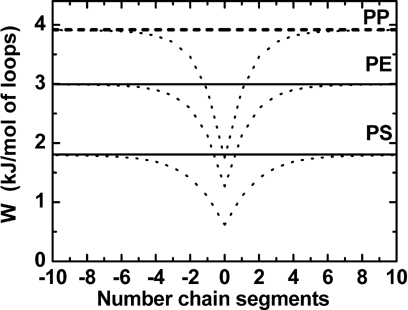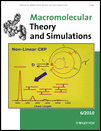Analysis of the Adequacy of the Representation of Entanglement Effects by Chain Loops
Corresponding Author
José A. Martins
Departamento de Engenharia de Polímeros, Universidade do Minho, Campus de Azurém 4800-058 Guimarães, Portugal, and CICECO, Universidade de Aveiro, 3810-193 Aveiro, Portugal
Departamento de Engenharia de Polímeros, Universidade do Minho, Campus de Azurém 4800-058 Guimarães, Portugal, and CICECO, Universidade de Aveiro, 3810-193 Aveiro, Portugal.Search for more papers by this authorCorresponding Author
José A. Martins
Departamento de Engenharia de Polímeros, Universidade do Minho, Campus de Azurém 4800-058 Guimarães, Portugal, and CICECO, Universidade de Aveiro, 3810-193 Aveiro, Portugal
Departamento de Engenharia de Polímeros, Universidade do Minho, Campus de Azurém 4800-058 Guimarães, Portugal, and CICECO, Universidade de Aveiro, 3810-193 Aveiro, Portugal.Search for more papers by this authorAbstract
It is generally considered that polymer chains are intertwined or “entangled” – because they cannot penetrate each other – and that these entanglements are responsible for melt elastic properties. There is no physical definition of entanglement. They are considered to be binary interactions between polymer chains and represented with the looping picture or by slip-links. The interaction energy of chain loops and of two Kuhn monomers is evaluated for several polymers. It is lower than the melt thermal energy, implying that chain loops or any other binary interactions between chain segments cannot account for the properties assigned to entanglements.
Supporting Information
Detailed facts of importance to specialist readers are published as ”Supporting Information”. Such documents are peer-reviewed, but not copy-edited or typeset. They are made available as submitted by the authors.
| Filename | Description |
|---|---|
| mats_201000005_sm_suppdata.pdf124.9 KB | suppdata |
Please note: The publisher is not responsible for the content or functionality of any supporting information supplied by the authors. Any queries (other than missing content) should be directed to the corresponding author for the article.
References
- 1 S. Rastogi, D. R. Lippits, G. W. M. Peters, R. Graf, Y. Yao, H. W. Spiess, Nat. Mater. 2005, 4, 635.
- 2 X. Wang, R. Liu, M. Wu, Z. Wang, Y. Huang, Polymer 2009, 50, 5824.
- 3 T. Vettorel, K. Kremer, Macromol. Theory Simul. 2010, 19, 44.
- 4 E. Ben-Naim, G. S. Grest, T. A. Witten, A. R. C. Baljon, Phys. Rev. E 1996, 53, 1816.
- 5 J. T. Padding, W. J. Briels, J. Chem. Phys. 2001, 115, 2846.
- 6 V. G. Mavrantzas, D. N. Theodorou, Macromolecules 1998, 31, 6310.
- 7 W. Paul, G. D. Smith, Rep. Prog. Phys. 2004, 67, 1117.
- 8 S. Q. Wang, S. Ravindranath, Y. Wang, P. Boukany, J. Chem. Phys. 2007, 127, 64903.
- 9 R. Everaers, S. K. Sukumaran, G. S. Grest, C. Svaneborg, A. Sivasubramanian, K. Kremer, Science 2004, 303, 823.
- 10 M. Doi, J. I. Takimoto, Phil. Trans. R. Soc. London A 2003, 361, 641.
- 11
T. A. Vilgis,
Prog. Colloid Polym. Sci.
1987,
75,
4.
10.1007/BF01188353 Google Scholar
- 12 N. Heymans, Macromolecules 2000, 33, 4226.
- 13 S. Q. Wang, Macromolecules 2007, 40, 8684.
- 14 Y. H. Lin, Macromolecules 1987, 20, 3080.
- 15 L. J. Fetters, D. L. Lohse, D. Richter, T. A. Witten, A. Zirkel, Macromolecules 1994, 27, 4639.
- 16
L. J. Fetters,
D. L. Lohse,
W. W. Graessley,
J. Polym. Sci., Part B: Polym. Phys.
1999,
37,
1023.
10.1002/(SICI)1099-0488(19990515)37:10<1023::AID-POLB7>3.0.CO;2-T CAS Web of Science® Google Scholar
- 17
J. M. Dealy,
R. G. Larson,
Structure and Rheology of Molten Polymers: From Structure to Flow Behaviour and Back Again,
Hanser,
Munich
2006, pp.
16,
203
10.3139/9783446412811 Google Scholar
- 18 J. F. Douglas, J. B. Hubbard, Macromolecules 1991, 24, 3163.
- 19 V. A. Parsegian, Van der Waals Forces: a Handbook for Biologists, Chemists, Engineers and Physicists, Cambridge University Press, New York 2006.
- 20 L. J. Salem, J. Chem. Phys. 1962, 37, 2100.
- 21 A. G. de Rocco, W. G. Hoover, Proc. Natl. Acad. Sci. USA 1960, 46, 1057.
- 22 R. Zwanzig, J. Chem. Phys. 1963, 39, 2251.
- 23 R. L. McCullough, J. J. Hermans, J. Chem. Phys. 1966, 45, 1941.
- 24 H. Margenau, N. R. Kestner, Theory of Intermolecular Forces, Pergamon Press, New York 1969.
- 25 J. Israelachvili, Intermolecular and Surface Forces, Academic Press, London 1992.
- 26 A. Kerdye, L. Galatry, Mol. Phys. 1985, 55, 1383.
- 27 J. Kleis, E. Schröder, J. Chem. Phys. 2005, 122, 164902.
- 28 D. Langbein, Phys. Kondens. Mater. 1972, 15, 61.
- 29 J. F. Nagle, D. A. Wilkinson, Biophys. J. 1978, 23, 159.
- 30 D. S. Pearson, G. Ver Strate, G. E. von Meerwall, F. C. Schilling, Macromolecules 1987, 20, 1133.
- 31 S. Q. Wang, G. D. Mahan, J. Chem. Phys. 1973, 59, 4029.
- 32 R. Zondervan, F. Kulzer, G. C. G. Berkhout, M. Orrit, PNAS 2007, 104, 12628.
- 33 H. Mendil, P. Baroni, L. Noirez, Eur. Phys. J. E: Soft Matter Biol. Phys. 2006, 19, 77.
- 34 R. M. Robertson, D. E. Smith, Macromolecules 2007, 40, 8737.
- 35 M. Kapnistos, M. Lamg, D. Vlassopoulos, W. Pyckhout-Hintzen, D. Richter, D. Cho, T. Chang, M. Rubinstein, Nat. Mater. 2008, 7, 997.
- 36 G. B. McKenna, B. J. Hostetter, N. Hadjichristidis, L. J. Fetters, D. J. Plazek, Macromolecules 1989, 22, 1834.
- 37 R. Qian, Macromol. Symp. 1997, 124, 15.
- 38 R. Qian, J. Macromol. Sci., Part B: Phys. 1999, 38, 75.





